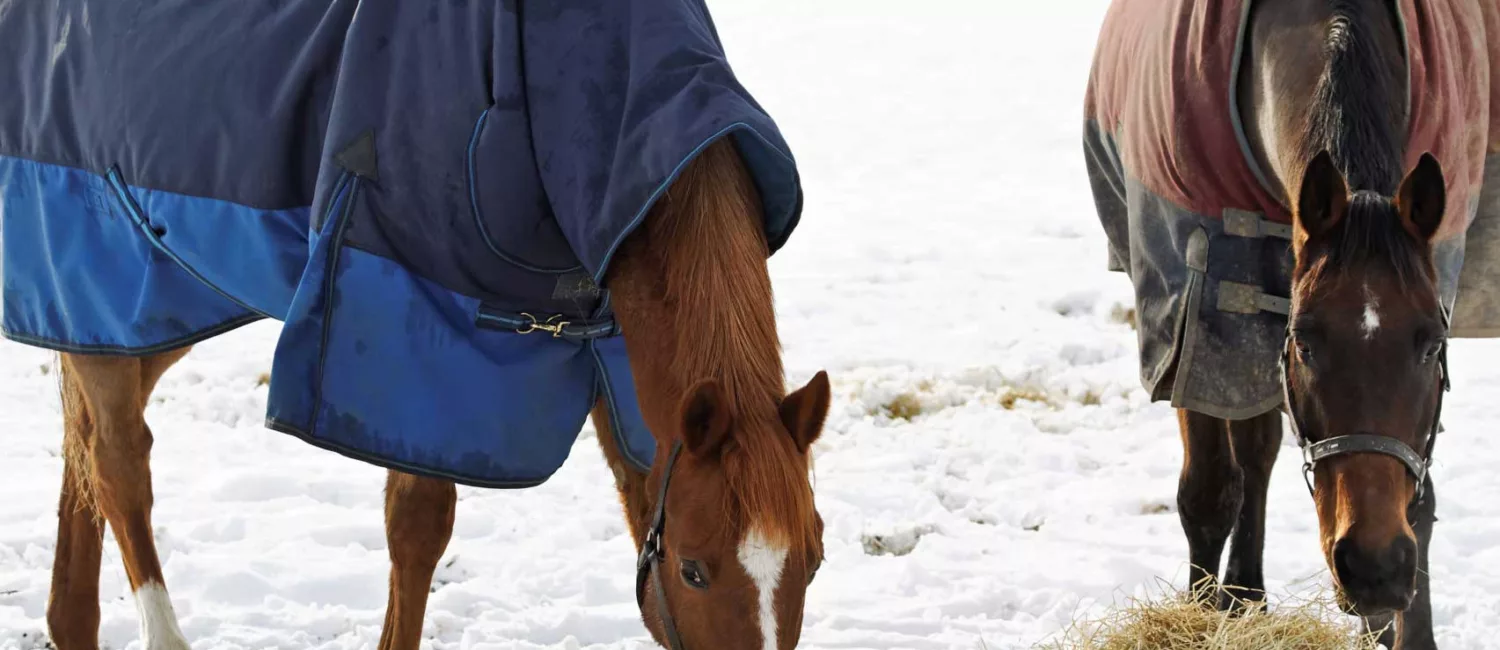As the nights begin to draw in and the temperature drops, you are probably turning your thoughts to what extra bags of feed can you buy to keep your horse in good condition throughout the cold winter. Well stop right there and save your hard earned money! Did you know, it’s not the few bags of hard feed that will keep weight on your horse when it is freezing cold, it’s actually the forage that your horse eats that maintains most of his condition. The key to feeding your horse in winter is to understand the basics of how his digestive system works together with a basic knowledge of how his forage changes through the seasons.
First, let’s look at an overview of his forage. As the temperature drops in autumn and the daylight hours decrease, the grass slows down its growth rate until eventually the soil temperature is too cold for the grass to grow with any significance at all. Without the sunshine to drive photosynthesis, without water (frozen water is not accessible to the roots), and a soil temperature below 4 degrees Celsius, the grass in your horse’s paddock becomes dormant. Dormant winter grass will be in shorter supply (there’s less of it as it’s not growing), less nutritious, lower in fibre and can contain less than half the calories of rich summer grass. However, watch out for warm sunny autumn days – the grass can put on a last short spurt of growth, producing stressed and high sugar content grass!
The other main type of forage fed to horses in the UK is hay. As you know, hay is made from dried grass, so the two are the same aren’t they? Well not exactly. The main difference between fresh grass and hay is the moisture content – grass is approximately 80% water, whilst well preserved hay will be less than 15% moisture. So straight away, we can see that per kilo of weight, hay has more calories than fresh grass because it contains much less water. Per kilo, hay contains a higher percentage of fibre than fresh grass, especially winter grass. However, hay tends to contain lower levels of vitamins, antioxidants and essential amino acids and fatty acids than fresh grass, especially the longer it is stored. These differences are important as your horse switches from eating mainly fresh grass in the summer to mainly hay in the winter. We need to look at the horse’s digestive system in more detail to understand why.
The high percentage of fibre in hay is not actually ‘digested’ by your horse, rather it is ‘fermented’ by the microbes in his hind gut. This process takes place mainly in the cecum – a large fermentation vat which is about 2.5 to 3 times bigger than the stomach. It can be thought of as the horse’s internal ‘compost heap’ – just like the microbes ferment and break down the fibres in the compost heap, and give off heat as they do so, the microbes in your horse’s cecum do exactly the same, and also give off heat. So the fermentation of fibre in the cecum acts as the boiler for your horse’s ‘central heating system’. It is this breakdown of fibre that provides the bulk of your horse’s calories in winter and also the crucial way of generating body heat and maintaining body condition in doing so. Fresh grass in winter usually does not contain enough fibre, plus there’s not enough of the winter grass available to fuel this ‘internal central heating system’. So the most efficient way to feed your horse in the cold winter months, to maintain body condition, is to provide truly ad lib hay so that he can eat sufficient fibre to fuel his ‘internal central heating system’. If you provide enough hay so that there are always a few handfuls left the next morning, then you know that your horse has had sufficient hay so that he has not had to go without during the night. As soon as the hay supply stops, the fuel for the central heating boiler stops, and he will start to feel the cold. Cold horses shiver and move around more to generate body heat through muscle activity, using calories and losing weight in the process. So feeding ad lib hay is the most efficient and cost effective way to maintain weight during the freezing winters. It’s a good way to keep ulcers at bay too.
But what about high fibre hard feeds, won’t these keep condition on your horse in the same way as hay? Well, technically high fibre hard feed will be fermented in the cecum the same as hay is, but you need to consider the amount of fibre they provide. Firstly, high fibre hard feeds are usually up to about 25% fibre content, whereas hay can be up to as high as nearly 40% fibre. Secondly, you need to consider the total amount needed. The average healthy horse at maintenance needs approximately 2% of its bodyweight per day in forage. That’s about 10kg of hay per day for a large 500kg horse, or a whopping 3 to 3.5 ton per year! On warmer days, your horse will eat less and on colder days he can eat significantly more – perhaps up to a whole small bale of hay per day in extremely cold weather, when the nights are below zero temperature and your horse is out 24/7 and not rugged. That amazing internal central heating system is why horses can survive outdoors without rugs at temperatures as low as minus 30 degrees Celsius in some countries. So as you can see, you would need to feed a lot of high fibre hard feed to match the amount of fibre he can eat from hay. Hay is cheaper per kilo than hard feed too! The exceptions to this are older horses with poor teeth that cannot chew hay effectively and those with a compromised hind gut that cannot ferment the fibre in hay efficiently. This is when high fibre hard feeds such as mashes made from grass nuts, etc can be useful as a hay replacer (even if they do work out more expensive). However, do check the ingredients of high fibre feeds – most are made from waste byproduct ingredients such as wheatfeed, oatfeed, chemically treated straw or genetically modified soya hulls. If your horse is not fermenting his hay efficiently and you think his hind gut function may be compromised, consider a digestive supplement and see if that helps to nutritionally support the guts to work better and utilise the hay.
So what are the main reasons for providing hard feed in winter? First and most importantly, to provide the essential nutrients that may be lacking in hay. Remember hay is usually lower in vitamins, essential amino acids, essential fatty acids and antioxidants than fresh grass. So choose a hard feed that is high in these essential nutrients to balance against your high fibre hay. A good complete feed or balancer is the best option. Secondly, hard feed can provide extra energy for horses that are in work. For example, if you feed oats to your horse, the calories are mainly provided as non structural carbohydrates. These carbohydrates are broken down in the small intestine to provide sugars that pass directly into the blood stream and give ‘instant access energy’ to your horse whilst working. So feeding oats and many other hard feeds which provide calories through carbohydrates, oil or protein, will provide energy for work, or if your horse is not working the calories will be laid down as fat. However these hard feeds based on carbohydrates, oils and proteins are not fermented by the microbes in the cecum. This means they don’t fuel the internal central heating system in the way that high fibre hay does, so they don’t keep your horse warm on a very cold winters night. That’s hay’s job!
So in summary, first and foremost this winter, feed truly ad lib hay especially on freezing cold nights when heat generation is needed. Top this up with a good quality complete feed or balancer to provide the essential nutrients that may be missing from the hay. Finally, only consider other hard feeds for extra energy for horses in work, or for horses with compromised digestive systems that need extra calories because their ‘internal central heating system’ is not working as efficiently as it should. This is a more natural feeding system for your horse and will be cheaper for you too!
Dr Deborah Carley is a qualified nutritionist and Managing Director of Thunderbrook Equestrian. For free nutritional advice contact www.thunder.localhost
This blog is part of an archived library. These blogs were originally written from 2009 through to 2014, so some are over a decade old (apologies the exact dates have been lost on website updates). Research and informed opinions are a constantly evolving stream of work, so there will always be updates required to any older blog post, research paper, etc. For the latest information, please email info@thunderbrook.co.uk or telephone 01953 797050 for nutritional advice. Thank you.

